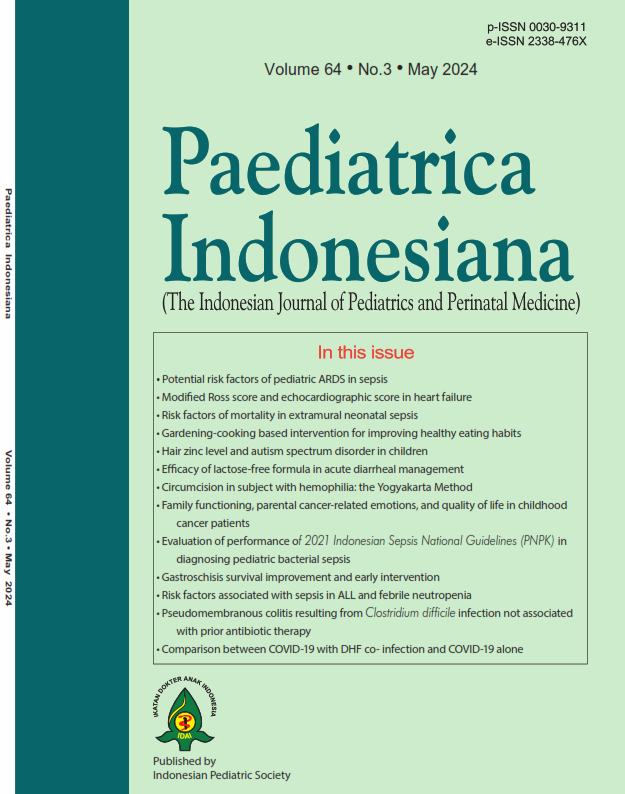Risk factors associated with sepsis in children with acute lymphoblastic leukemia and febrile neutropenia
Abstract
Background Children with acute lymphoblastic leukemia (ALL), especially those with febrile neutropenia, are susceptible to sepsis. Several factors have been associated with the occurrence of sepsis in children with leukemia.
Objective To identify potential risk factors associated with sepsis in children with ALL and febrile neutropenia.
Methods This cross-sectional study was done in children with ALL who sought treatment at Dr. Hasan Sadikin General Hospital, Bandung, Indonesia from January 2019 to March 2022. We recorded patients’ gender, age, nutritional status, absolute neutrophil count (ANC), co-infection, prophylactic antibiotic use, and phase of chemotherapy.
Results Of 131 subjects, 57.3% were male and 42.8% were wasted. Subjects had a median age of six years old and median ANC of 230 cells/mm3. Furthermore, 48.9% of subjects had co-infections, 87.8% had not received prophylactic antibiotics, and 48.9% were in the induction phase of chemotherapy. Multiple logistic regression analysis revealed that older age [OR 1.16 (95%CI 1.04 to 1.29); ?=0.149; P=0.008] and co-infection [OR 12.9 (95%CI 5.01 to 33.21); ?=2.551; P<0.001] were significantly associated with sepsis in children with ALL and febrile neutropenia. Bronchopneumonia was the most common co-infection (72.5%).
Conclusion Older age and co-infection are significantly associated with sepsis in children with ALL and febrile neutropenia.
References
2. Prajapati Z, Kokani M, Gonsai R. Clinicoepidemiological profile of hematological malignancies in pediatric age group in Ahmedabad. Asian J Oncol. 2017;03:54–8. DOI: https://doi.org/10.4103/2454-6798.209330
3. Gavidia R, Fuentes SL, Vasquez R, Bonilla M, Ethier MC, Diorio C, et al. Low socioeconomic status is associated with prolonged times to assessment and treatment, sepsis and infectious death in pediatric fever in El Salvador. PLoS One. 2012;7:e43639. DOI: https://doi.org/10.1371/journal.pone.0043639
4. Zhu Y, Yang R, Cai J, Yu J, Tang Y, Chen Y, et al. Septicemia after chemotherapy for childhood acute lymphoblastic leukemia in China: a multicenter study CCCG-ALL-2015. Cancer Med. 2020;9:2113–21. DOI: https://doi.org/10.1002%2Fcam4.2889
5. Hanzelina H, Widnyana AANKP, Windiani IGAT, Karyana IPG, Ariawati NK, Mahalini DS. Malnutrition as risk factor for febrile neutropenia in children with acute lymphoblastic leukemia. Open Access Maced J Med Sci. 2022;10:681–5. DOI: https://doi.org/10.3889/oamjms.2022.8448
6. Aisyi M, Dwijayanti F, Wigati R, Mahdi HI, Yunus L, Chainurridha C, et al. Sepsis in children with acute lymphoblastic leukemia. Indones J Cancer. 2020;14:121. DOI: https://doi.org/10.33371/ijoc.v14i4.738
7. Muenchhoff M, Goulder PJR. Sex differences in pediatric infectious diseases. J Infect Dis. 2014;209(Suppl3):s120-S126. DOI: https://doi.org/10.1093/infdis/jiu232
8. Santolaya ME, Alvarez AM, Aviles CL, Becker A, Venegas M, O’Ryan M, et al. Prospective validation of a risk prediction model for severe sepsis in children with cancer and high-risk febrile neutropenia. Pediatr Infect Dis J. 2013;32:1318–23. DOI: https://doi.org/10.1097/01.inf.0000436128.49972.16
9. Bourke CD, Jones KDJ, Prendergast AJ. Current understanding of innate immune cell dysfunction in childhood undernutrition. Front Immunol. 2019;10:1728. DOI: https://doi.org/10.3389/fimmu.2019.01728
10. Asturias EJ, Corral JE, Quezada J. Evaluation of six risk factors for the development of bacteremia in children with cancer and febrile neutropenia. Curr Oncol. 2010;17:59–63. DOI: https://doi.org/10.3747%2Fco.v17i2.453
11. Freifeld AG, Bow EJ, Sepkowitz KA, Boeckh MJ, Ito JI, Mullen CA, et al. Clinical practice guideline for the use of antimicrobial agents in neutropenic patients with cancer: 2010 Update by the Infectious Diseases Society of America. Clin Infect Dis. 2011;52:e56-e93. DOI: https://doi.org/10.1093/cid/cir073
12. Kuo FC, Wang SM, Shen CF, Ma YJ, Ho TS, Chen JS, et al. Bloodstream infections in pediatric patients with acute leukemia: emphasis on gram-negative bacteria infections. J Microbiol Immunol Infect. 2017;50:507–13. DOI: https://doi.org/10.1016/j.jmii.2015.08.013
13. Das A, Trehan A, Bansal D. Risk factors for microbiologically-documented infections, mortality and prolonged hospital stay in children with febrile neutropenia. Indian Pediatr. 2018;55:859–64.DOI: https://doi.org/10.1007/s13312-018-1395-0
14. Inaba H, Pei D, Wolf J, Howard SC, Hayden RT, Go M, et al. Infection-related complications during treatment for childhood acute lymphoblastic leukemia. Ann Oncol. 2017;28:386–92. DOI: https://doi.org/10.1093/annonc/mdw557
15. Alexander S, Fisher BT, Gaur AH, Dvorak CC, Luna DV, Dang H, et al. Effect of levofloxacin prophylaxis on bacteremia in children with acute leukemia or undergoing hematopoietic stem cell transplantation a randomized clinical trial. JAMA. 2018;320:995–1004. DOI: https://doi.org/10.1001/jama.2018.12512
16. Ozdemir N, Tuysuz G, Celik N, Yantri L, Erginoz E, Apak H, et al. Febrile neutropenia in children with acute lymphoblastic leukemia: single center experience. Turk Pediatri Ars. 2016;51:79–86. DOI: https://doi.org/10.5152/TurkPediatriArs.2016.2757
17. World Health Organization. Definitions and key terms. Guideline: Assessing and managing children at primary health-care facilities to prevent overweight and obesity in the context of the double burden of malnutrition: updates for the integrated management of childhood illness (IMCI). World Health Organization; 2017. Available from: https://www.who.int/publications/i/item/9789241550123
18. Singer M, Deutschman CS, Seymour CW, Shankar-Hari M, Annane D, Bauer M, et al. The Third International Consensus Definitions for Sepsis and Septic Shock (Sepsis-3). JAMA. 2016;315:801-10. DOI: https://doi.org/10.1001/jama.2016.0287
Copyright (c) 2024 An nieza Dea Versary

This work is licensed under a Creative Commons Attribution-NonCommercial-ShareAlike 4.0 International License.
Authors who publish with this journal agree to the following terms:
Authors retain copyright and grant the journal right of first publication with the work simultaneously licensed under a Creative Commons Attribution License that allows others to share the work with an acknowledgement of the work's authorship and initial publication in this journal.
Authors are able to enter into separate, additional contractual arrangements for the non-exclusive distribution of the journal's published version of the work (e.g., post it to an institutional repository or publish it in a book), with an acknowledgement of its initial publication in this journal.
Accepted 2024-06-14
Published 2024-06-14













